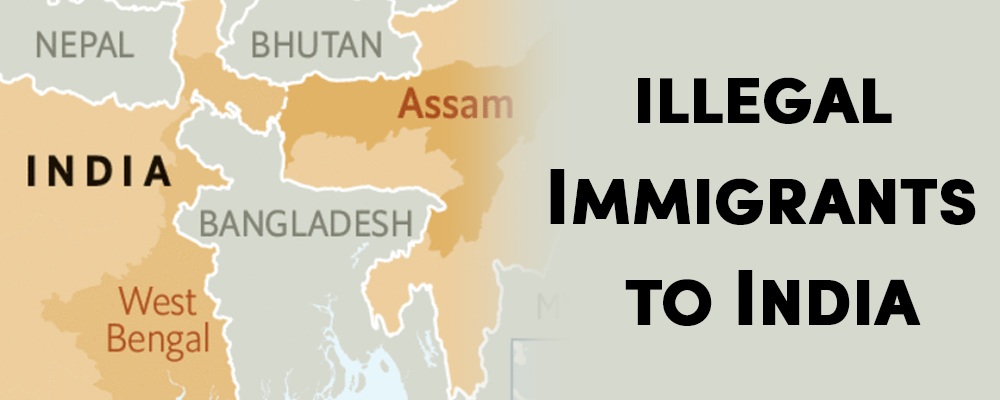People migrate to other nations in search of a better life, peace, economic security, etc. Migration is a global phenomenon. Each nation makes every effort to manage immigration and stop illegal immigration, yet many of these efforts are futile. Illegal immigration has significant demographic and social repercussions and the potential to exacerbate tensions and hostility between newcomers and the local population. India has made very little progress in preventing and limiting illegal immigration, and the situation in its northeastern states is particularly alarming. Illegal immigration from Bangladesh over the border has harmed these states. India has a land border with Bangladesh on three sides. Large-scale illegal immigration from Bangladesh is a significant problem in Assam and has historically resulted in several ethnic confrontations.
The Illegal Migrants (Determination by Tribunals) Act, 1983:
The Illegal Migrants (Determination by Tribunals) Act, 1983 was passed by the Indira Gandhi administration. The Act took effect on October 15, 1983, but only in the state of Assam, even though it applied to all of India. The Foreigners Act of 1946 covered India’s other states. The Illegal Migrants Act had a similar goal of the previous administration’s effort: expelling immigrants and defending Indian nationals.
Illegal immigrants were defined in Section 3(c) of the Act.
Any person who meets the criteria listed below is an illegal immigrant, pursuant the Section:
- He arrived in India after March 25, 1971.
- Is a foreign national.
- Has entered India without a current passport or another active piece of identification.
Need A Legal Advice
The internet is not a lawyer and neither are you. Talk to a real lawyer about your legal issue

A list of those to whom the Act does not apply was included in Section 2 of the Act:
- Any person found to be a foreigner upon entry from any of India’s international borders;
- Any foreigner who entered India with a valid passport and visa but is still residing in India even after the expiration of his visa;
- Any person who has been deported from India before the commencement of this Act or any such person who has been deported under any other law in effect.
This Act cleared the ground for the creation of legal tribunals in Assam to determine whether a person is an Indian citizen or a foreigner. The government had the burden of proof in this case, unlike the Foreigners Act of 1946. The government offered the accused a fair chance to verify his identification by setting up tribunals. The person had the opportunity to appeal to the Appellate Tribunal if they were not happy with the Tribunal’s judgement.
Illegal Migrants (Determination) Tribunals:
According to the Act, the Central Government may appoint as many Illegal Migrants (Determination) Tribunals as it deems necessary. Each Tribunal must exercise its authority within its own boundaries.
There should be a minimum of two members on each Tribunal. Either a district judge or an additional district judge in a state must be the person nominated to the Tribunal.
There are two methods for submitting a request to the Tribunal:
- Against a government order designating someone a foreigner and ordering them to leave the country.
- By anyone else declaring someone to be an undocumented immigrant.
The Tribunal had the following authority:
- Summoning, requiring the presence of, and questioning under oath witnesses;
- Finding and producing any document;
- Acceptance of affidavit-based evidence;
- Requesting from any court or office public records;
- Creation of any commission for witness examination.
This process needed to be completed swiftly in order to be successful, hence Section 13 of the Act mandated that the reference made to the Tribunal be investigated immediately and resolved within six months of the date of service.
Appellate Tribunal:
The central government was to provide instructions for the establishment of the Appellate Tribunal, which will have a minimum of two members and a maximum of six. The person must be a High Court Judge in order to qualify to serve on that Appellate Tribunal. Within 30 days of the Tribunal’s decision, an appeal may be filed with the Appellate Tribunal. If the Appellate Tribunal was pleased with the reason for the delay after the passing of thirty days, the case would be taken; otherwise, the Tribunal’s judgement would be final.
Sarbananda Sonowal v. Union Of India (2005)
There was a great deal of pressure to repeal the IMDT Act due to its ineffectiveness, and in 2000, Assamese citizen and former president of the All Assam Student Union and chairman of the North East Students Association Sarbananda Sonowal filed a writ petition under Article 32 of the Indian Constitution, alleging that certain provisions of the Illegal Migrants (Determination by Tribunals) Act, 1983, are unconstitutional. The State of Assam and the Union of India both responded.
Justice R.C. Lahoti, Justice G.P. Mathur, and Justice P.K. Balasubramanyan was on a three-judge panel that recognised the hardship of the Assamese people, who were becoming a minority in their own state. The Illegal Migrants (Determination by Tribunals) Act, 1983, and the Illegal Migrants (Determination by Tribunal) Rules, 1984, were both deemed illegal by the court in its ruling on July 12, 2005. All cases that were pending before the tribunals established under the IMDT Act were transferred to the tribunals established pursuant to the Foreigners (Tribunals) Orders of 1964, and all cases were to be decided in accordance with the provisions of the Foreigners Act and the rules promulgated thereunder.





 Talk to a Lawyer
Talk to a Lawyer